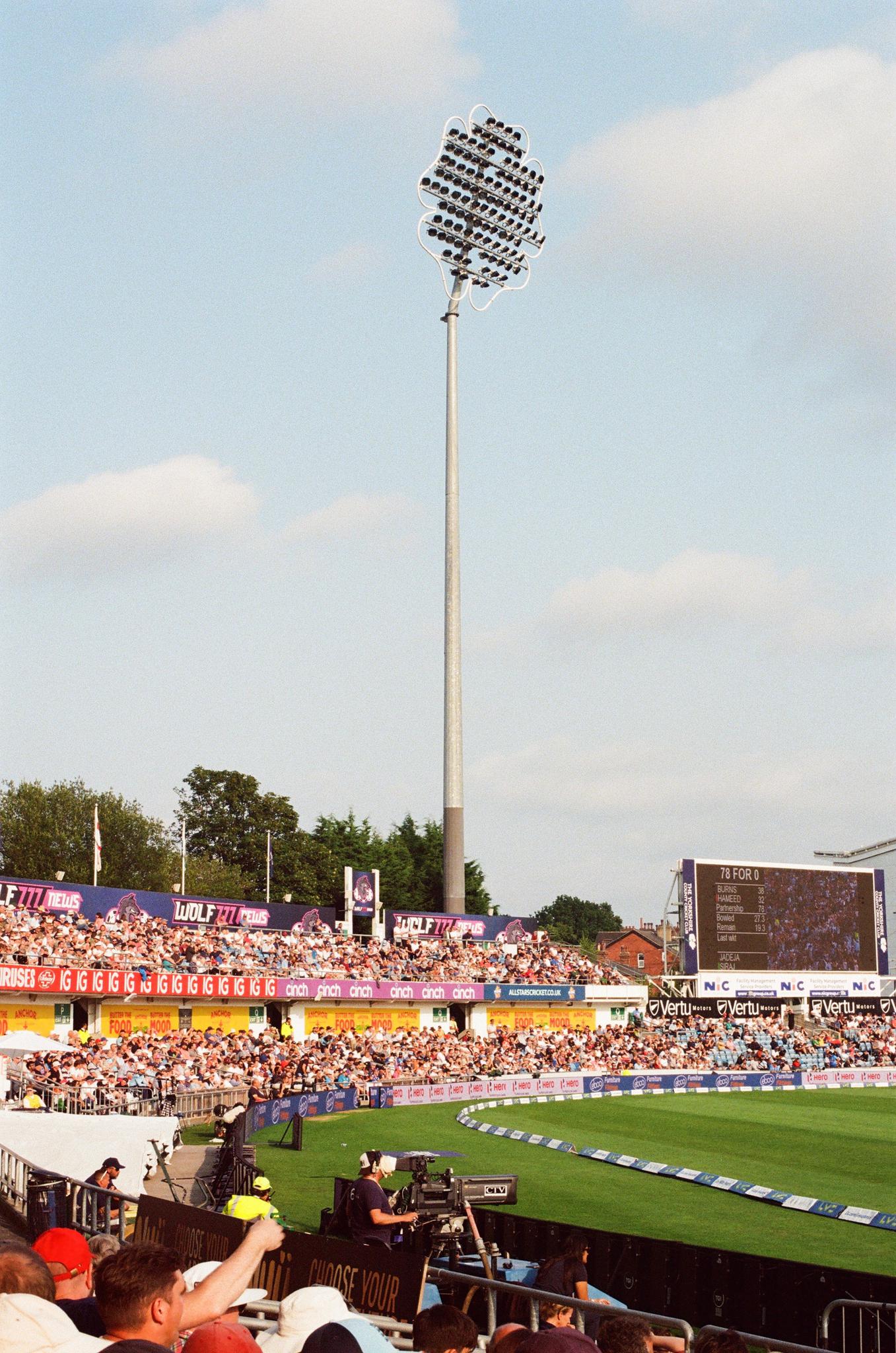Why funding cuts cannot be the answer to England Cricket’s ‘white’ noise on racism.
Over the last year, long-standing concerns over racism in the sport of cricket have come to the forefront of the British media’s attention. First, former West Indian cricketer, Michael Holding published his impassioned book ‘Why We Kneel, How We Rise’. Commentator and former England cricketer, Mark Butcher’s acclaimed series ‘You Guys Are History’ told the stories of cricketers of colour and the racism they suffered. Then came the investigation into racial discrimination at Yorkshire County Cricket Club, involving Azeem Rafiq, a Yorkshire cricketer of Muslim Pakistani heritage.
In all of these ways, 2021 has given stage to a number of burning questions about the institutionalised racism and discrimination in English Cricket. Professional selection is supposedly just down to ‘who is best’ and therefore, any lack of diversity in county and national teams ‘is not about race’. But when opportunity and investment is skewed in favour of the rich and a correlation between wealth and whiteness is very apparent in this country, then who is best is, in fact, directly about race.
The history of the game sets the scene for its legacy of snobbery. The stereotypical image of an English gentleman, most likely Tory, most certainly upper class, and undoubtedly white, consumes many people’s perceptions of a cricketer in the UK. Nationally dating back to the 18th century and growing globally in the 19th and 20th centuries, the sport is a core symbol of English culture. Quite obviously, these origins reflect a pre-modern and uniformly white representation of the game that stand in strong contradiction to today’s multicultural makeup of our population. What was once presided over as an ‘Imperial Game’, spread and loved throughout the Empire, became a source of contention with the collapse of that Empire in the 1960s/70s. Where white power was overturned, cricket remained, nurtured and nourished by newly independent nations, now competitors such as India, Pakistan, the West Indies. A new face of the sport abroad also sought to reshape the game at home, with immigration and the Windrush generation changing the face of English Cricket.
The true face of English Cricket is no longer the white gentleman and Azeem Rafiq has been the most prominent example to call out the cricketing world’s institutional resistance to this change. Taking more than a year to launch an investigation into his claims of racial harassment and bullying, Yorkshire County Cricket has now seen several resignations from its board, as well as the departure of its entire coaching staff and the suspension from television commentating duties of its former captain, Michael Vaughan. Much more than this, the scandal has prompted a much wider scrutiny of English Cricket’s stance on anti-racism. Not only is the issue about attitudes within the game, it’s about levels of participation and access for people of a non-white origin and how this breeds its exclusivity.

Organisations such as the ECB and PCA have been required to address their apparent disconnect with ethnic minority communities, acknowledging a number of barriers that prevent the wider involvement of a greater diversity of players. From facilities, to coaching, urban areas have been deprived of the same funding as more rural locations, commonly populated with private schools with their own, greater, white, student populations. It currently appears an impenetrable road to professional cricket for those who cannot afford to attend such privileged institutions and, with the government urged to cut funding if changes are not made, this destination seems further and further away.
The Digital, Culture, Media and Sport Committee’s report on racism recommends that any future public funding for the ECB should depend on evidence of its progress in tackling anti-racism, as documented in quarterly reports. Whilst a fair threat given the board’s previous empty promises to resolve this issue – what happened to the Clean Bowl Racism campaign in 2000, the 2018 South Asian Action Plan, or even projects dating back to the 90s? – the reality of withdrawing funding can only exacerbate the very problem it is trying to target.
The ECB receives about £2.5m annually from Sport England, most of which goes towards developing grassroots cricket. What should be scrutinised more heavily is their frivolous spending of the much larger fund of £68m that once lay in reserve, but which has now been whittled down to just £2m. What could have been a nice sum better invested in advancing local cricket facilities and scouting up and down the country, was actually blown on a nice, new, shiny format last summer known as The Hundred. In recent years, the board has found itself relying on bailout money, resorting to staff cut-backs, mainly sacrificing those in the development team and yet, strangely enough, their overall employment numbers rose from 379 to 416 in the same period. The Hundred required players, coaching staff and a larger events team. Despite ‘cutting’ staff, the ECB’s payroll actually rose by £6.6m in 2020, again taking from the rather fragile pot reserved for grassroots. There is no doubt that the means to expand English Cricket’s reach at development level are there. What isn’t there is the understanding or the will to make this a priority.
Grassroots is the most basic form of the game. It is where you will find every lover of cricket before they are tested by obstacles of money and other resources that are required to progress. This includes the least privileged players, those that cannot necessarily afford the kit and equipment needed to play at club level, or even to travel there. It is where a lot of South Asian players get left behind, providing 30% of the recreational pool, but only 4% of professional cricketers. There is a serious demand for more British-Pakistani, Indian, and West Indian professional cricketers. There is certainly no lack of desire to make the journey, there is just no money or support behind their efforts.
Sport England’s ‘Sports Participation and Ethnicity in England’ National Survey finds that participation in cricket is at its highest in Pakistani men at 10%. Next highest at 8% is‘Black Other’, with Indian with 6%. This compares to just 2% of English men on average. The same can be said for women, with 2% participation for Bangaladeshi and the same for Pakistani, compared to less than 1% for the female population on average. Having a basic interest in cricket shows a much higher percentage and follows the same trend, with these ethnicities far surpassing the overall national average. However, from showing a greater interest in the game and a far higher level of amateur participation, these groups have gone on to represent just 13.44% of contracted male professional players in county cricket and just 5.17% of female in 2021, according to the PCA. A bottleneck emerges when it comes to progressing from school and club cricket to county and national.

State schools are having to raise their own assets in order to deal with budget cuts and years of austerity. The government’s website reveals that 215 playing fields have been sold off in England over the last decade. If you are a child that goes to a school without playing fields and you don’t live near a local cricket club, or have a parent/guardian with the means to take you there, then the upshot is that you are very unlikely to play and progress. The Independent Schools 2020 Census determined the percentage of ‘minority ethnic’ student’s in the UK’s private schools to be almost the same as in the state sector. However, Hadley Freeman notes that ‘minority ethnic’ is a big umbrella term and whilst those in state schools are largely black and Asian inner-city children, in private schools, they tend to be wealthy foreign students. Hence, cricket’s predominant focus on selections from private schools lends itself to a homogenously white team from wealthy backgrounds. We may all have the same twenty-four hours in the day, but time is inevitably wasted if we don’t have the resources to make use of it in the way that we desire. No matter how deeply we want to acquire the necessary skills, or to gain access to the right facilities, equipment and people to achieve this, our ability to do so goes far beyond an individual’s drive and want for it. In the world of professional sport, it requires someone else’s want for you to win – in the form of governmental and organisational funding.
Therefore, it comes at no surprise that the current team largely reflects a wealth of privately educated backgrounds. Rory Burns (Whitgift), Dominic Sibley (Whitgift), Zak Crawley (Tonbridge), Joe Root (WorksopCollege), Ollie Pope (Cranleigh), Jos Buttler (King’s College, Taunton), Dominic Bess (Blundell’s School), Sam Curran (Wellington College), Stuart Broad (Oakham), are all privately educated. Chris Woakes (Barr Beacon Language College), James Anderson (St Theodore’s Roman Catholic High School), and Ben Stokes (Cockermouth School) can speak for a small minority of state school attendees. A study by Cricket Bet India summarises this best: just 6% of the UK population has been privately educated on average, yet this grows to 37.5% of England Test cricketers in 2020 and an outrageous 62.5% for men that is simply out of touch with reality.
New face, same body. As the pool of potential players hasvastly diversified – batting and bowling out in the city side streets and urban parks – the organisations that determine who takes to the professional field remain rather stuck. You go on the ECB’s website to take a look at their list of Executives and what you find is one non-white face out of eleven: Sanjay Patel, Managing Director for The Hundred. You go on the list of Board members and, again, just two of eleven: Valerie Amos and Ron Kalifa. Across the game there are only a handful of black or Asian coaches, with the demand for finance and academic qualifications standing in the way of many. Is it any wonder that money is spent on a new tournament format rather than encouraging wider community involvement in the sport, when those communities do not sit at the decision table?
Scyld Berry has even called out the possibility that England would perform better as a more diverse side. With bowling setting up a series of problems for batters to solve, the greater a team’s diversity, the better their chances of reaching an answer. Berry detects that “if every England player comes from the same background, and is coached in the same way every step of his career, accidents like 58 all out will happen again”, referring to England’s 2018 Test against New Zealand at Eden Park. And it did (almost). The most recent Ashes Series saw England all out for 68 runs on Day 3 of the 3rd Test in Melbourne, their lowest scoring innings on Australian soil since 1904. So how can change hurt us more than this 4-0 series defeat? There are already talks of a shake-up in the squad, so let’s start talking about a real earthquake that reaches down into the depths of grassroot squads to un-tap every source of potential because we know it’s there.
Sporting diversity is not an act of tokenism. It is an asset. And it can only be tapped by addressing the evident imbalance of opportunity. Funding is paramount if we are to make the development of professional cricketers a level playing field for people of all backgrounds.
